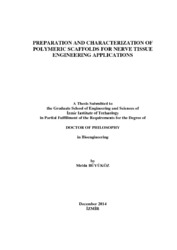Please use this identifier to cite or link to this item:
https://hdl.handle.net/11147/4301| Title: | Preparation and characterization of polymeric scaffolds for nerve tissue engineering applications | Other Titles: | Sinir doku mühendisliği uygulamalarında kullanılmak üzere polimerik doku iskelelerinin hazırlanması ve karakterizasyonu | Authors: | Büyüköz, Melda | Advisors: | Alsoy Altınkaya, Sacide Erdal, Şerife Esra |
Keywords: | Biomaterials Tissue engineering Nerve growth factors |
Publisher: | Izmir Institute of Technology | Source: | Büyüköz, M. (2014). Preparation and characterization of polymeric scaffolds for nerve tissue engineering applications. Unpublished doctoral dissertation, İzmir Institute of Technology, İzmir, Turkey | Abstract: | The major goal in tissue engineering is to develop three-dimensional biomimetic scaffolds which can provide an optimal environment for cell adhesion, proliferation, differentiation and guide new tissue formation. In this study macroporous, nanofibrous gelatin scaffolds in the form of a disc and channeled conduit were prepared for nerve tissue engineering applications. Alginate microspheres have been integrated into the scaffolds to deliver nerve growth factor (NGF) to differentiate PC12 cells. Methods combining thermally induced phase separation technique with porogen leaching and injection molding were used to manifacture disc shaped and channeled nanofibrous scaffolds, respectively. Microcarriers loaded with NGF were fabricated by water-in-oil emulsification technique and attached in the scaffold by chemical crosslinking with carbodiimide reaction. The relationship among processing parameter, porosity, pore size, interpore connectivity and the mechanical properties were investigated. In addition release kinetics of NGF from the particles were determined and viability, proliferation and differentiation of PC12 cells in the scaffolds were evaluated. The fiber sizes of nanofibrous scaffolds were found similar to the size of natural collagen fiber bundles. In nanofibrous scaffolds, the dimensional stability and in vitro degredation rates improved when compared to solid walled scaffolds. The release rate of NGF from the particles was controlled by the alginate concentration and poly(L-lysine) coating. Integrating NGF into the nanofibrous gelatin scaffold in encapsulated form reduced amount of NGF and time required for the differentiation of PC12 compared to free NGF directly added to the cells. | Description: | Thesis (Doctoral)--İzmir Institute of Technology, Bioengineering, İzmir, 2014 Full text release delayed at author's request until 2018.01.19 Includes bibliographical references (leaves. 84-93) Text in English; Abstract: Turkish and English xiv, 97 leaves |
URI: | http://hdl.handle.net/11147/4301 |
| Appears in Collections: | Phd Degree / Doktora Sürdürülebilir Yeşil Kampüs Koleksiyonu / Sustainable Green Campus Collection |
Files in This Item:
| File | Description | Size | Format | |
|---|---|---|---|---|
| T001331.pdf | DoctoralThesis | 4.88 MB | Adobe PDF |  View/Open |
CORE Recommender
Page view(s)
144
checked on Sep 23, 2024
Download(s)
72
checked on Sep 23, 2024
Google ScholarTM
Check
Items in GCRIS Repository are protected by copyright, with all rights reserved, unless otherwise indicated.